Mayday Movement USA, a grassroots organization seeking Trump’s impeachment through lobbying, art, and mutual aid, holds sit-in on National Mall.
June 6, 2025
Washington, DC
This is part of an ongoing story covering the Mayday Movement USA’s 24/7 sit-in on the National Mall to lobby Congress to impeach and remove President Trump. Subsequent articles will be released as the Movement progresses.
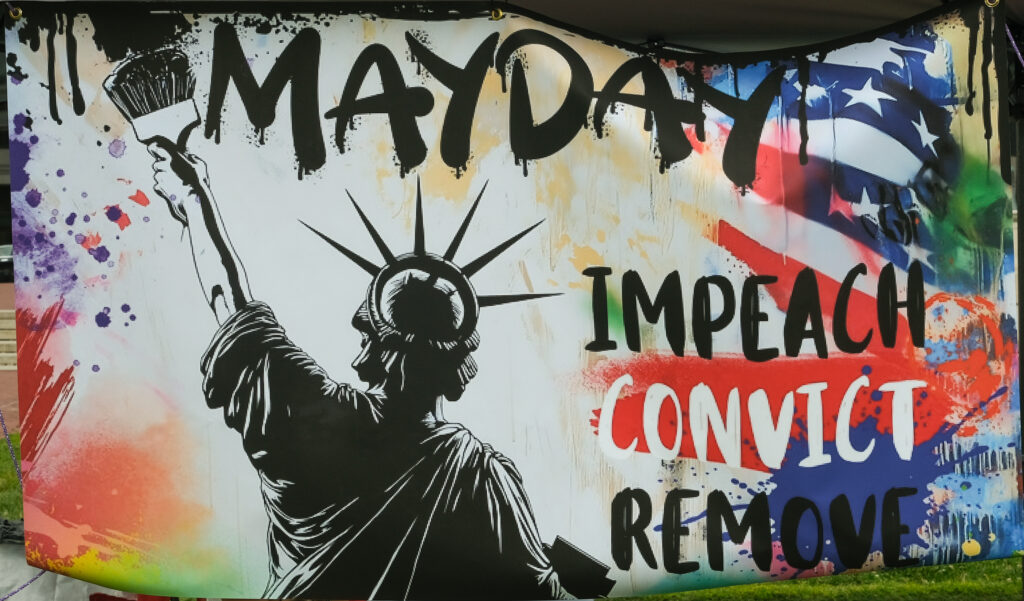
Since May 1, the Mayday Movement USA has held a 24/7 sit-in throughout the National Mall, most recently located outside Union Station. The movement calls for the impeachment and removal of President Trump, and focuses on art, mutual aid and community outreach, congressional outreach, and holding a presence on the Mall. In Mayday’s perspective, their primary goal is to uphold the Constitution, and it considers itself to be fundamentally patriotic and non-partisan. “[Impeachment] is not a partisan issue,” says Peter, the originator of Mayday. “[It is a] moral and ethical one.”
Most Mayday volunteers describe it as a patriotic effort lobbying Americans and Congress to uphold constitutional norms. American flags are seen frequently throughout the movement’s sites and are even encouraged. Volunteers have passed around a copy of the Constitution to sign, and there is caution in selecting which groups they align with to ensure they are clear in their intent: Americans exercising their First Amendment protected speech to call on their representatives to change what Mayday sees as a devolution into autocracy.
In the movement’s congressional lobbying arm, volunteers bring constituents to meet their representatives in person. Mayday volunteers have sought confirmations from representatives that they will vote yes on impeachment and even presented Rep. Thanedar (D-MI-13) with the Movement’s inaugural “Good Trouble” award (previously covered here).
However, despite Mayday’s relative success in lobbying Congress and obtaining constituent signatures for impeachment, as the movement progresses its organizers acknowledge more needs to be done. Now it is at an inflection point as it seeks to expand its numbers, with volunteers beginning to experience the strain that a 24/7 movement brings and increasing frustration over what some in Mayday see as the Democratic Party’s failure to uphold the Constitution. Still, the organizers and volunteers press on with the feeling that if they can convince more Americans to take action over what Mayday sees as an impending constitutional crisis, they could win the hearts and minds of Congress.
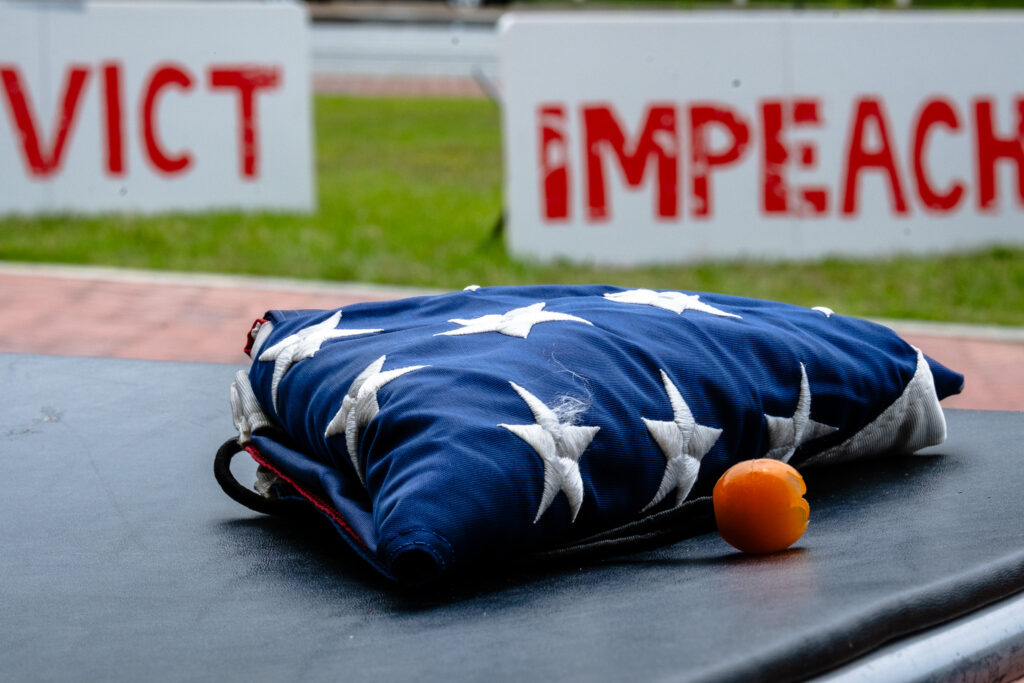
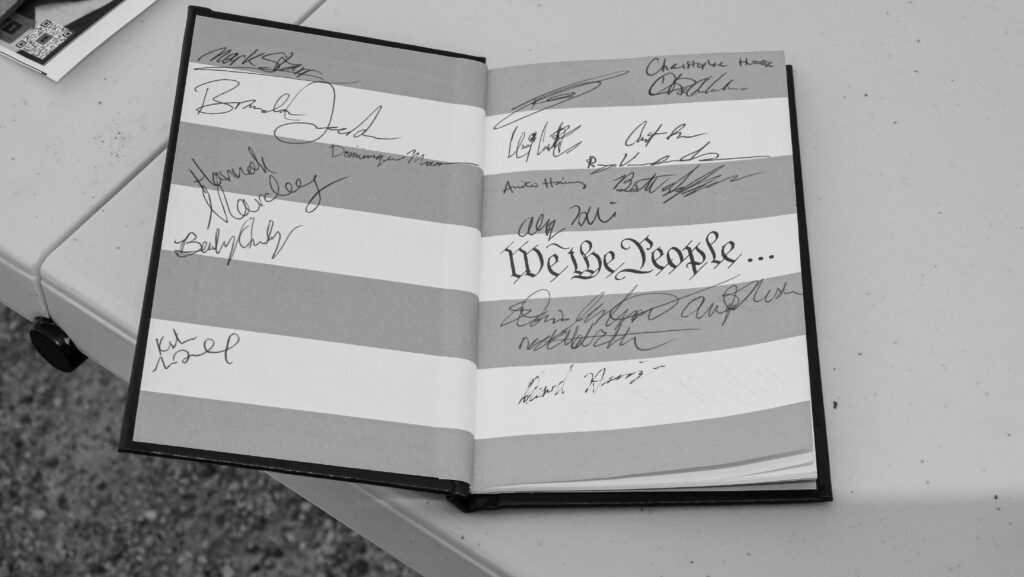
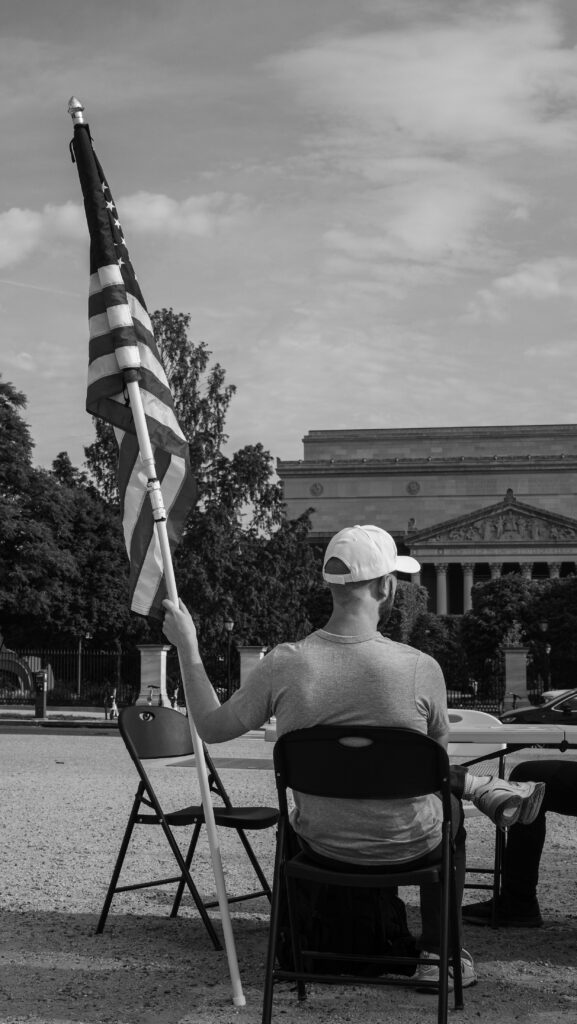
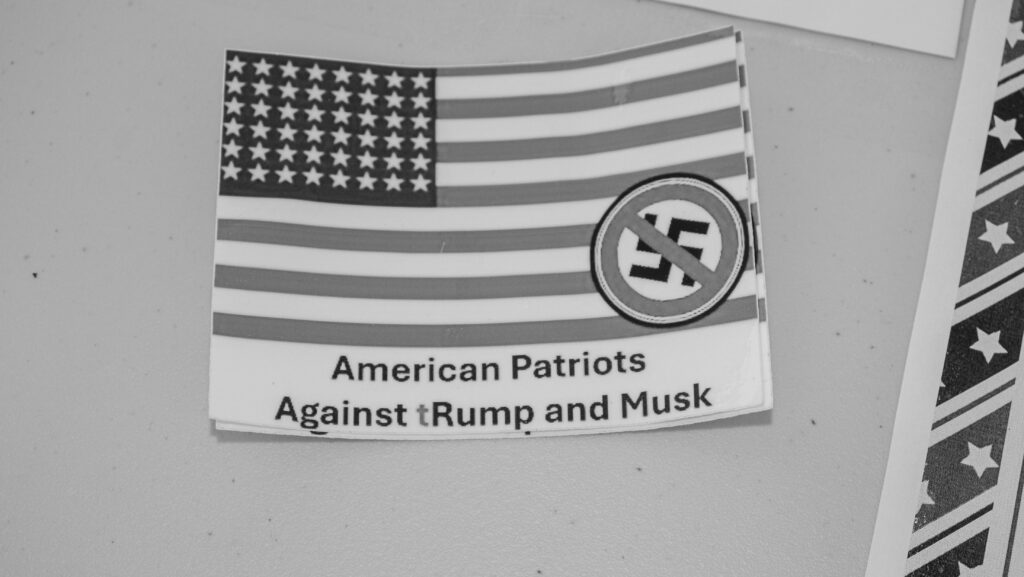
Mayday’s Grassroots Beginnings
Volunteers make up the majority of Mayday, almost all of them coming from across the nation, including California, Georgia, New Jersey, North Carolina, Illinois, New Mexico, and elsewhere. Since its beginning, these volunteers comprise a variety of roles, including medical professionals, organizers, and artists. On day one, it saw several hundred people show up. Since then, its consistent presence is primarily the result of the volunteers, some of whom have uprooted their lives in pursuit of the vision Mayday has laid out. Many of the volunteers on site until recently were the same ones present from the first day.
Mayday was originally conceived by Peter, a former federal employee and Coast Guard member who enjoyed retirement until the most recent election. Peter says he believes his background in organizational development (focusing on strategic planning, incident management, and leadership development) helped prepare him for the challenge of organizing a grassroots-level effort that would require people from across the country to participate.
“I was doomscrolling at the end of February and calling my representatives daily, but it fell on deaf ears,” Peter explained. He described how he started to think about historic events, like the 1955 Montgomery Bus Boycott and the 1932 Bonus Army, the World War I veterans who occupied the National Mall to demand Congress release the bonuses they had been promised for their service in the war. “I first took the oath to defend the Constitution 45 years ago. … [I] thought the oath to protect against domestic enemies was metaphorical, and I’ve come to see that’s not the case.”
From this frustration and the inspirations of older movements, Peter published a Reddit post. Peter says he posted a meme calling for a 24/7 movement on the Mall to demand Trump’s impeachment and removal around March. This kicked off a two-month planning spree with four original members who found Peter through the post, and who took it upon themselves to establish medical support and other logistics, like permitting. Peter is quick to emphasize that Mayday is peaceful and focuses on free speech, and describes three core pillars: congressional operations, community outreach, and art as resistance. “We’re playing Field of Dreams—if we build it, they will come. The permit allows 300 protesters and 150 volunteers onsite,” says Peter. He has since taken a step back from a leadership role at Mayday to allow those on site to manage its day-to-day operations but remains pivotal to seeing the original vision succeed.
Mayday Movement’s Operations
Congressional Ops Wing and Impeachment Action Center
“We’re trying to be proactive as opposed to reactive.”
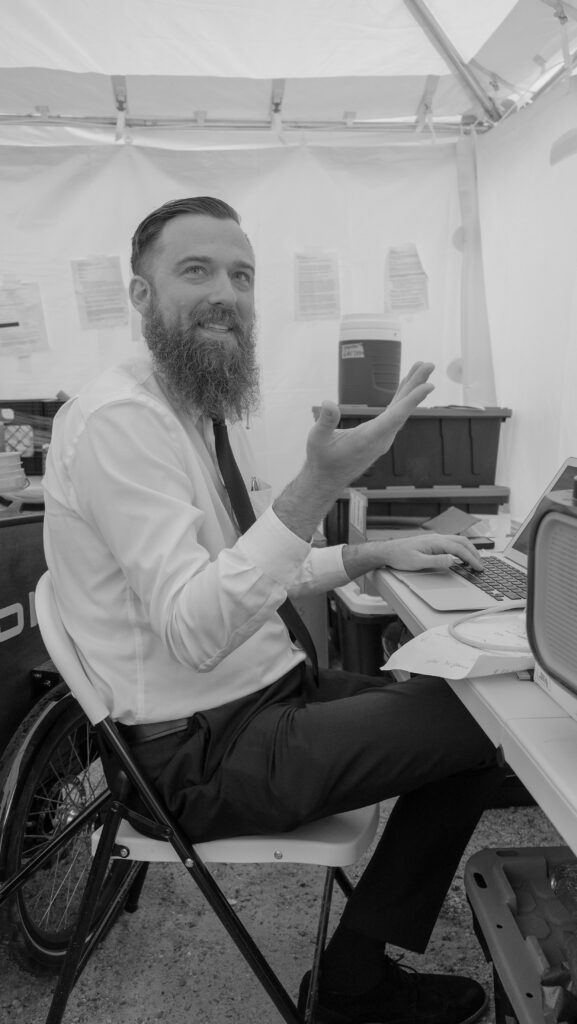
The Impeachment Action Center (IAC) is the congressional operations wing of Mayday Movement that handles all constituent and congressional outreach, and is a centerpiece for Mayday. Its role includes physically connecting constituents directly with their representatives on the Hill and delivering statements for impeachment signed by constituents passing by the Mayday plot. One of the leads for this effort is Dave, a social worker from Pennsylvania who has prior experience in humanitarian work and helping people with PTSD and traumatic brain injuries. “You can’t rely on all the smart people on the Hill—or lack thereof—to, you know, come up with every answer to every problem. Solutions can come from the people too,” says Dave. According to Dave:
“The Mayday Movement has the ability to take those declarations and deliver them on behalf of constituents. So I like to consider myself not just a constituent or a congressional outreach lead, but an actual citizen’s advocate. So it’s advocating for the people that support this.”
Dave has noted that they have several thousand signatures from constituents calling for impeachment, mostly passersby who walk past Mayday’s plot. He also says they have taken hundreds to meet directly with their representatives or their staffers.

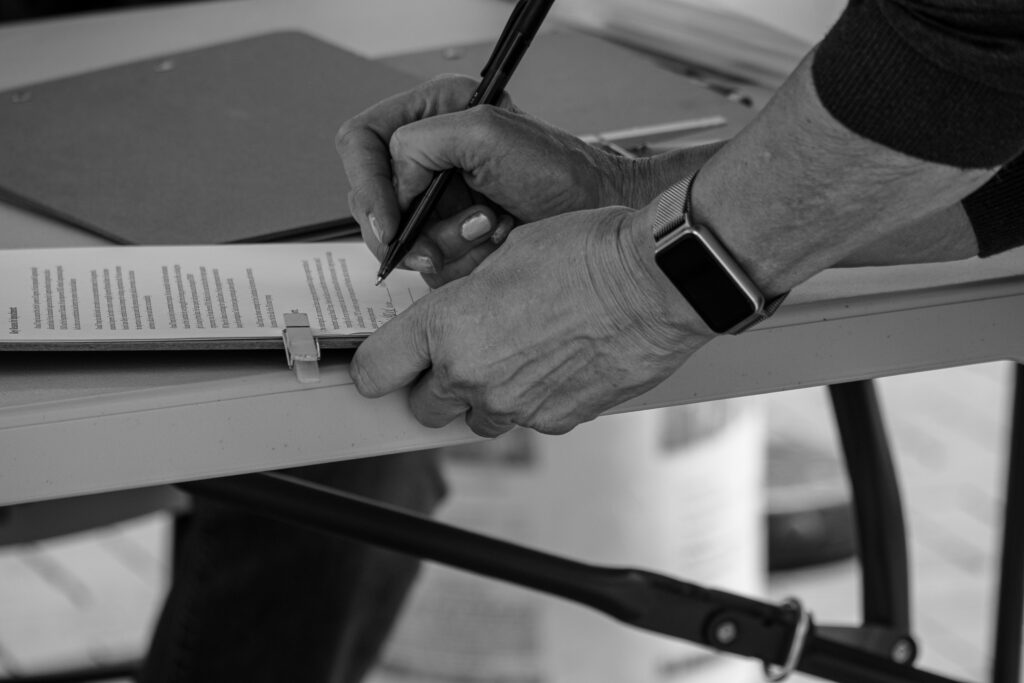
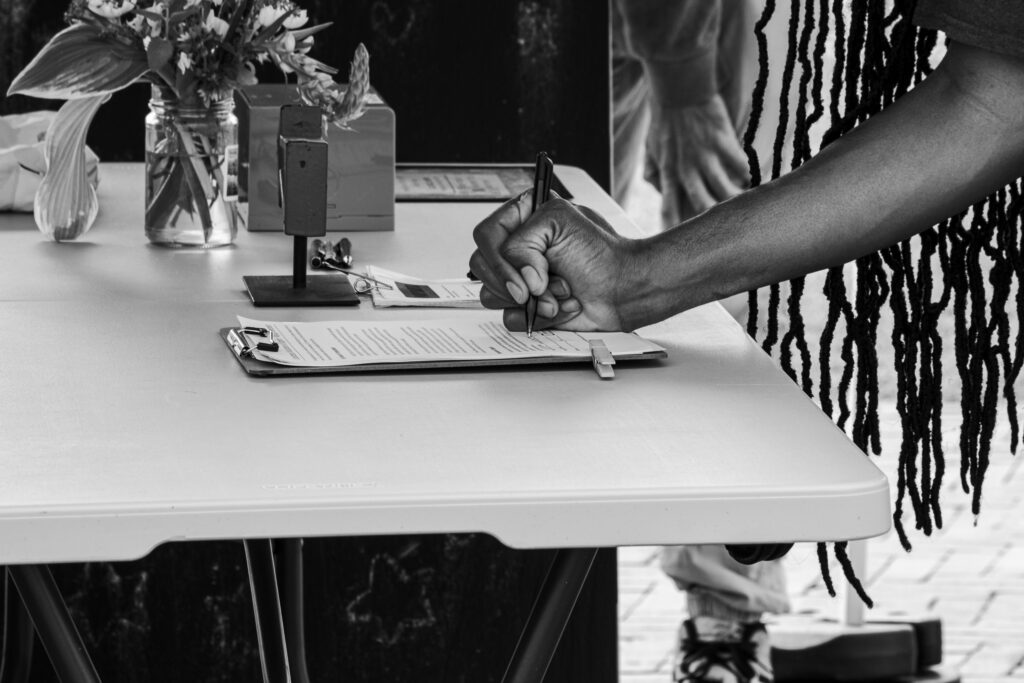
During interviews, reporters asked Dave whether their lobbying has had any success so far.
“We just got our first [on May 8]. We got Ayanna Pressley from Massachusetts. … She had publicly stated she supported impeachment in a townhall recently, but we wanted to make sure that goes on the record. … The person that [we] met [with] on her behalf, the staffer, said she absolutely supports impeachment.”
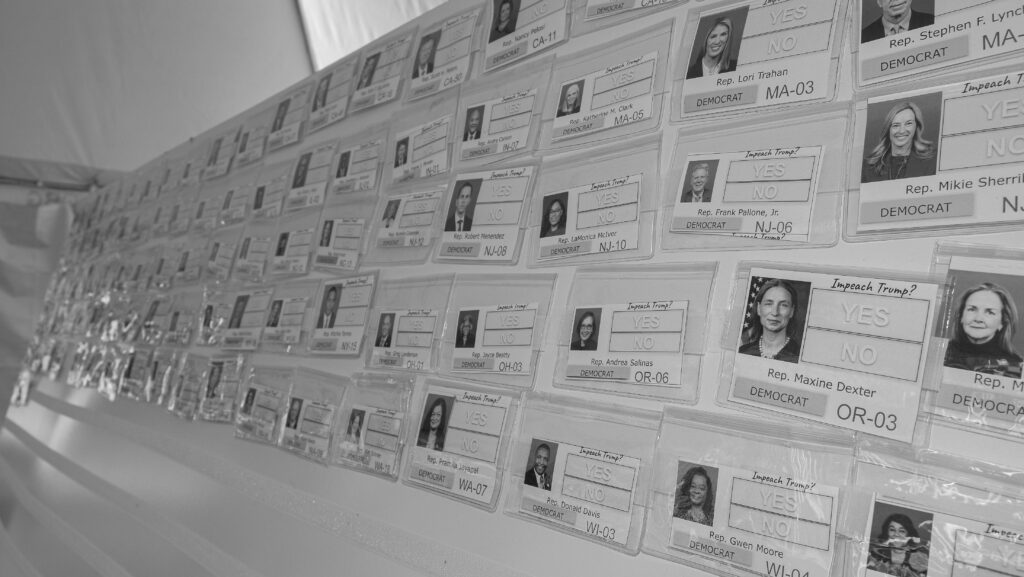
In addition to direct congressional lobbying, Dave is also one of the key organizers of Mayday’s presentation of their inaugural Good Trouble award to Representative Thanedar for his articles of impeachment, before Rep Thanedar withdrew them from the House floor on May 14. Organized by Mayday’s public affairs lead and the IAC team, Mayday walked to Representative Thanedar’s office in the Cannon Building to present him with the award.
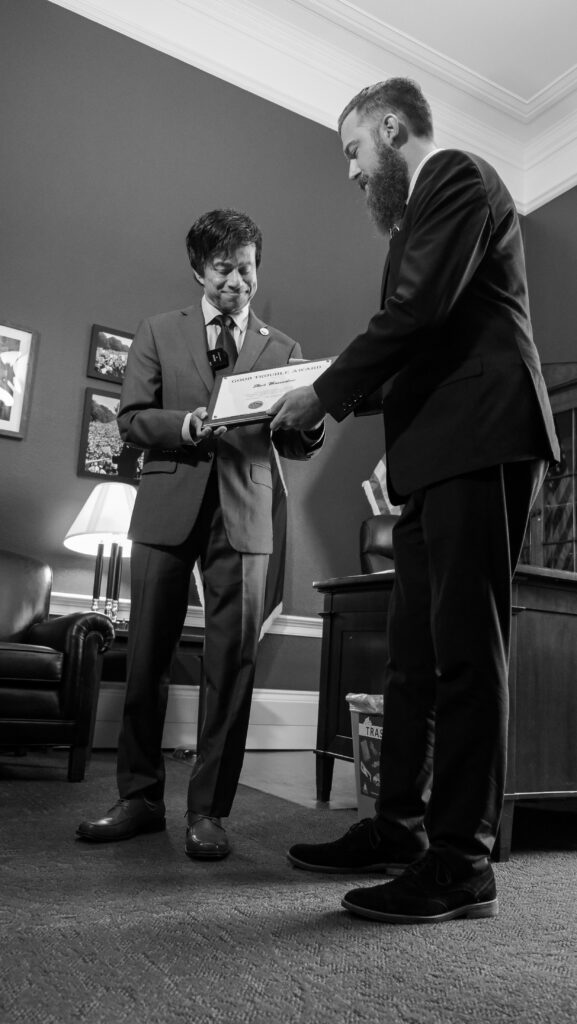
However, just one week later Representative Thanedar abruptly withdrew his articles over cited pressure from Democratic Party leaders. This hesitancy in the Democratic Party has also been observed directly by Mayday. Dave noted early in the Movement: “We had the only ‘no’ from Representative Beyer from Virginia. … And his answer was, ‘Well, I’m just being honest.’” Dave also remarked at the time that:
“Right now a lot of the messaging I get from the meetings with the staffers is ‘we’re going to be reactive to Trump,’ and people know that at this point, a proactive response or proactive strategy to deal with Trump is what’s needed. Because otherwise he’s just going to continue eroding [legal processes and institutions].”
Others have similarly expressed disappointment in how Democrats are approaching the issue of impeachment, with one volunteer saying, “It appears as an outsider that the Democrats are doing politics as usual.” Another noted that “I’m not surprised, but disappointed.”
“Democratic leadership still thinks the system will save them,” said Dave, paraphrasing a staffer he spoke with. And Dave has indicated that some staffers have expressed frustration to him privately over what they see as an unwillingness by the representatives they work for to make politically risky moves, including supporting impeachment publicly. “Right now it wouldn’t be politically expedient for their representatives to come out in favor of impeachment,” Dave said.
“Some staffers know what’s happening on the Hill is unfair. The Democratic Party’s unwillingness to relinquish control is the cause of a lot of these problems.”
Based on these issues, Mayday acknowledges the challenges it faces in successfully seeking removal of President Trump as they face a minority in both the House and Senate. But Dave and others in the IAC team and Mayday don’t see any other option:
“The defeatist, you know, obey-in-advance mentality is not common here within the Mayday Movement, and if there is a possibility, you know, we’ve got to explore it—the stakes are that high. … But yeah, tall order. We’re not disillusioned. I realize it’s—the likelihood is not high, but that’s not the point. A lot of people like to obey in advance and go ‘well, if you have don’t have good odds, I don’t want to take the risk,’ and in terms of my life, and how I live my life, some of the most beautiful things we’ve seen in humanity [are from] taking risks.”
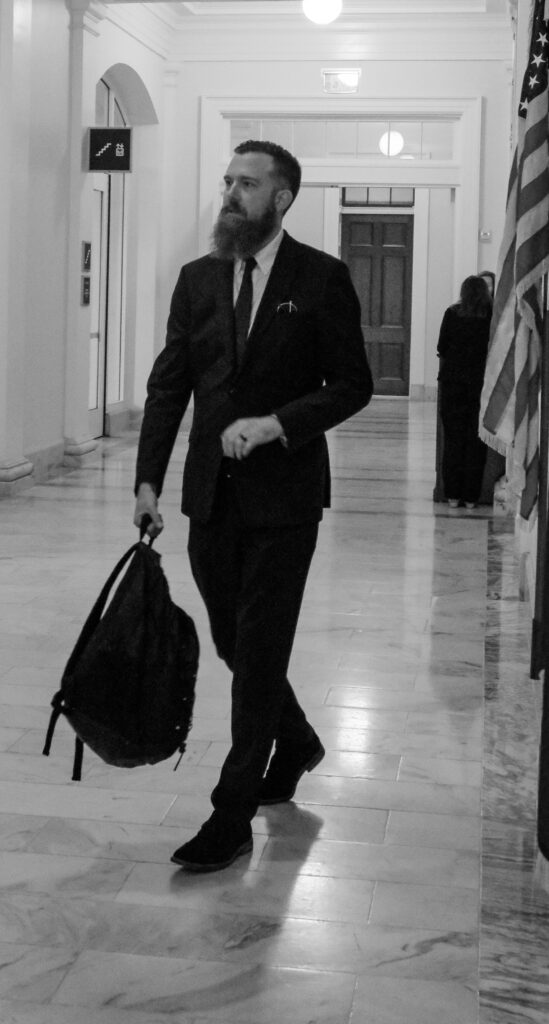
Still, speaking further about Mayday’s push to lobby Congress despite these seemingly improbable odds, Dave noted a partial win in Representative Beyer:
“So yeah, we got … Representative Beyer from a ‘no,’ and we got him to the non-committal.
As of June 6, Mayday says it has secured 15 confirmations from Democratic representatives for impeachment.
“At the end of my life … I’ve got to be okay with myself,” says Dave. “Sometimes we don’t have the luxury of knowing the outcome of a struggle. … [There are] things here that are still working, so have hope because we’re not fully fascist yet, and I hope we won’t be.”
Art as Resistance Wing
“Art is the core of resistance.”
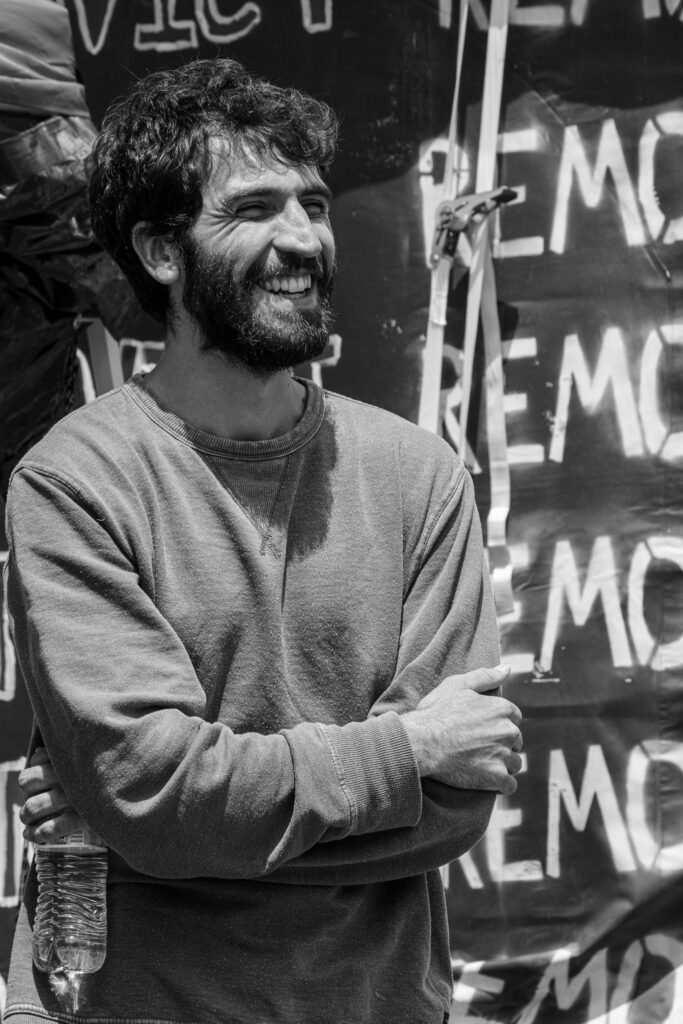
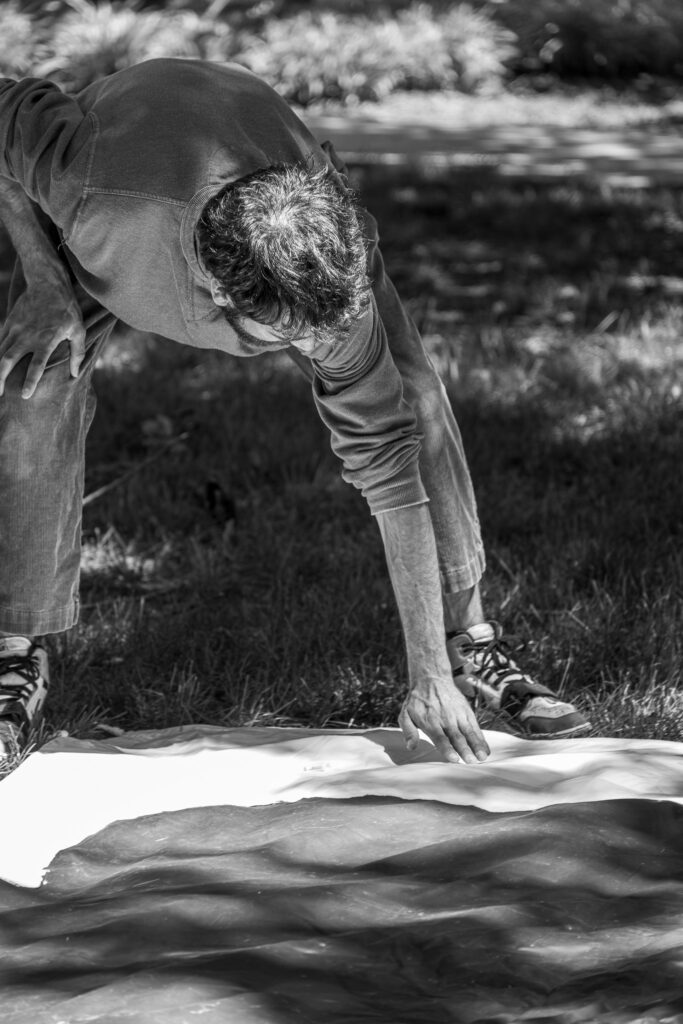
Like other volunteers at Mayday, Milo is from out of state. He came with his father shortly after the movement started to see it and decided to stay. Now he has been designated as an Art Response Lead by Peter, and says his role primarily consists of coordinating the art response efforts on site and working with Mayday’s social media team to promote the movement through art. “Art is at the core of resistance,” Milo said during an interview. “We need to see the resistance [illustrated through the art on site], and we need to see the fire in each other.”
Milo says the art wing has a number of projects it is pursuing to accomplish this. Projects like canvassing, coordinating offsite painting (painting is not allowed onsite due to permit restrictions), coordinating content approach with the social media team, and coordinating live music. These broadly bucket into three focus areas: visual arts and video, music, and performance art.
Asked about the constraints that Mayday has to navigate due to permitting restrictions, Milo noted that it “puts a real damper” on the art response activities. All painting and chalk has to be done completely off site, due to National Park Services concern that it could be used to damage property. As a result, Milo spends time coordinating with artists to help provide them with the material and space where they can express themselves artistically, while remaining compliant with the permit.
“Nick [the performing arts lead] is doing outreach with art studios and churches to see if we can use their spaces once or twice a month.”
“The lifestyle I worked so hard for—living my American dream—and it felt like I knew I wasn’t the only one getting hurt.”
Another volunteer supporting the live music effort is Mark, a singer-songwriter from Albuquerque, New Mexico, who recalled driving 30 hours in his RV to move to DC. Mark is now a key participant in Mayday’s art wing.
Before joining Mayday, he says he had an import business that supported him, until the December after President Trump was elected.
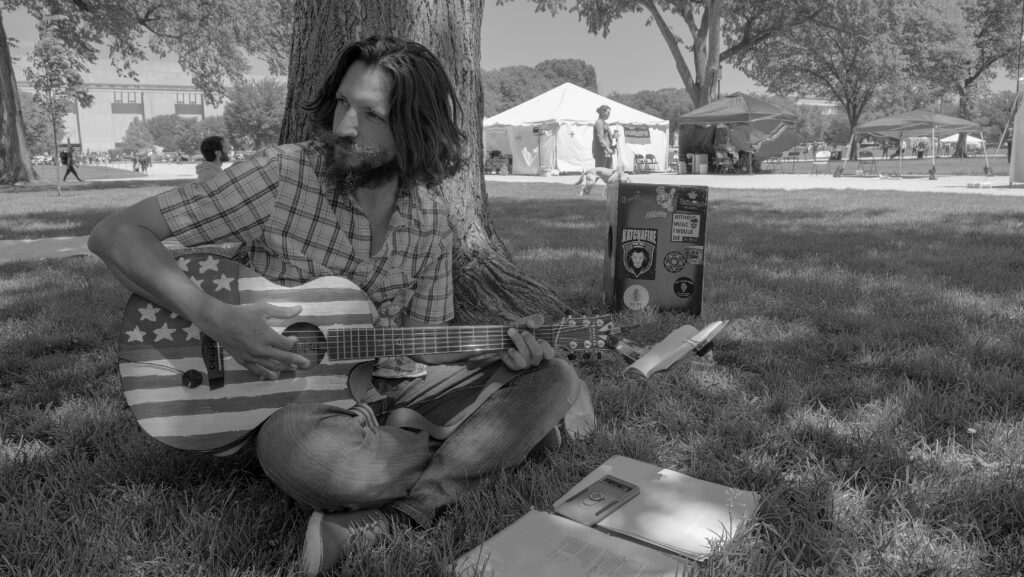
“I’m a doer. I worked to build an import business, and then Trump won in November. Then in December, where they should have peaked, sales were about 50% where they should’ve been in December. … Then the tariffs came.”
After losing his business, Mark recalled talking with his girlfriend about what he was going to do next. “Do I go to the White House and just start [] playing songs…?” Around this time, Mark says he discovered Mayday online and joined: “these are my people.”
Mark says he has been writing songs for 20 years. He is now using that talent with Mayday, writing protest songs that express his frustration with the current administration, and with Democrats who will not file articles of impeachment.
He is also unabashedly patriotic, emphasizing that this is part of why he participates in Mayday: “The resistance of the rise of authoritarianism is the most patriotic movement since the Civil Rights movement.”
To emphasize this, Mark painted his guitar with the American flag. He also noted his disagreement with groups that want to see the Constitution thrown out or who seek to undermine it, emphasizing his belief in the founding document.
“Who has morals that they live up to? Hopefully, everyone’s morals are higher than what they can achieve. And if you write into the government, that government is for the people—even if you’re the elite of the day: that’s an incredible ideal that can’t be completed in a lifetime.”
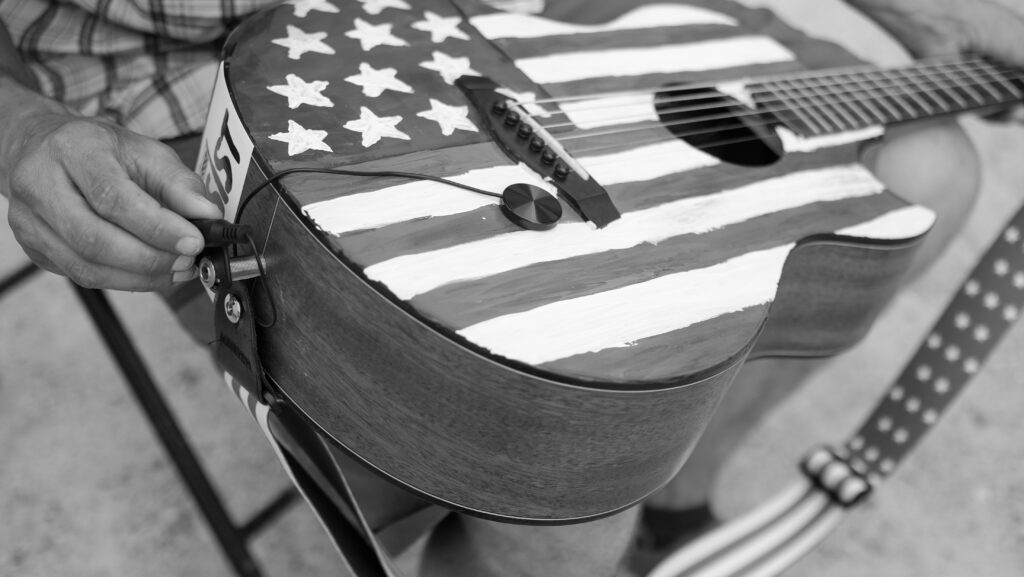
Medical Support, Mutual Aid, and Community Outreach Wing
“People have the right to exercise their First Amendment safely. Any form of gathering has inherent danger; people should always have a safety net.”
Mayday Movement has also partnered with other grassroots activist organizations, including 50501 Movement and Street Medic Aid and Supply Hub (SMASH). SMASH, a 501(c)(3) non-profit led by medical professionals, was founded in March 2025 and collects and distributes essential medical supplies through grassroots networks. The group supports volunteers, protesters, and anyone in the vicinity of Mayday Movement USA’s site who require medical attention, according to the founders. When asked whether SMASH is exclusive to Mayday, one co-founder commented:
“[We] don’t care if you’re here for [Mayday], or just to visit … We are here to care, because our hospitals are falling apart at the seams, and that’s where street medics come in.”
One of the founders of SMASH, Jey, has been onsite since the beginning, taking a travel job at a local hospital in Maryland to be closer to Mayday. Jey, an ER nurse in a Level 2 Trauma Center, co-founded SMASH with another medical professional named CB, who is a patient care technician in a Level 1 Trauma Center. Both are from out of state. While Jey has moved to Maryland, CB travels between her home state, Delaware, and DC to support the non-profit, while also continuing its operations further north, including in Philadelphia.
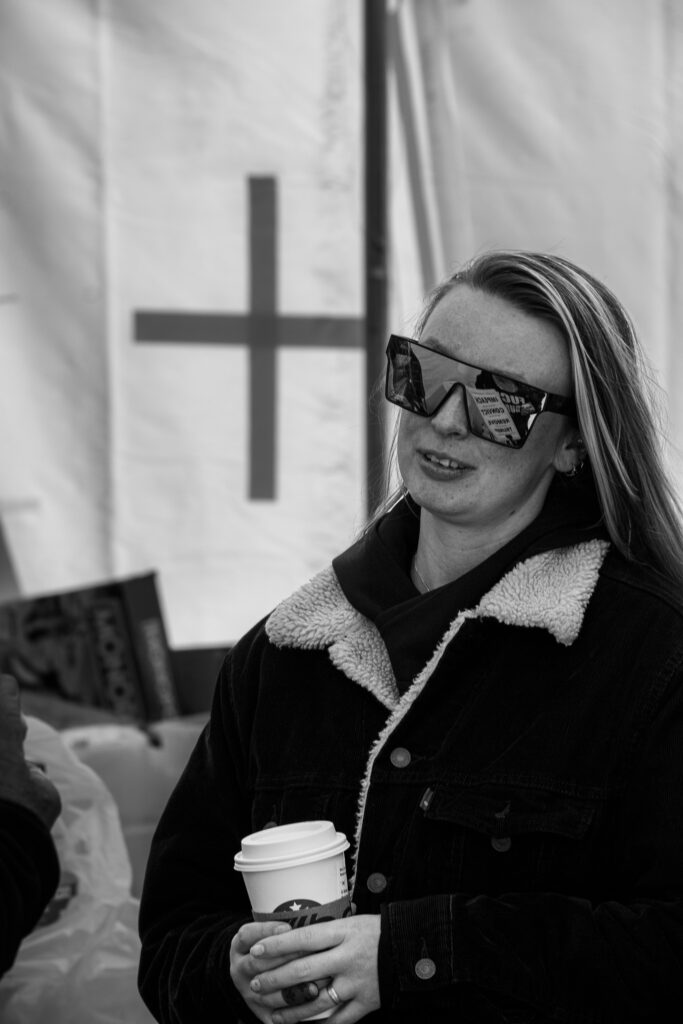
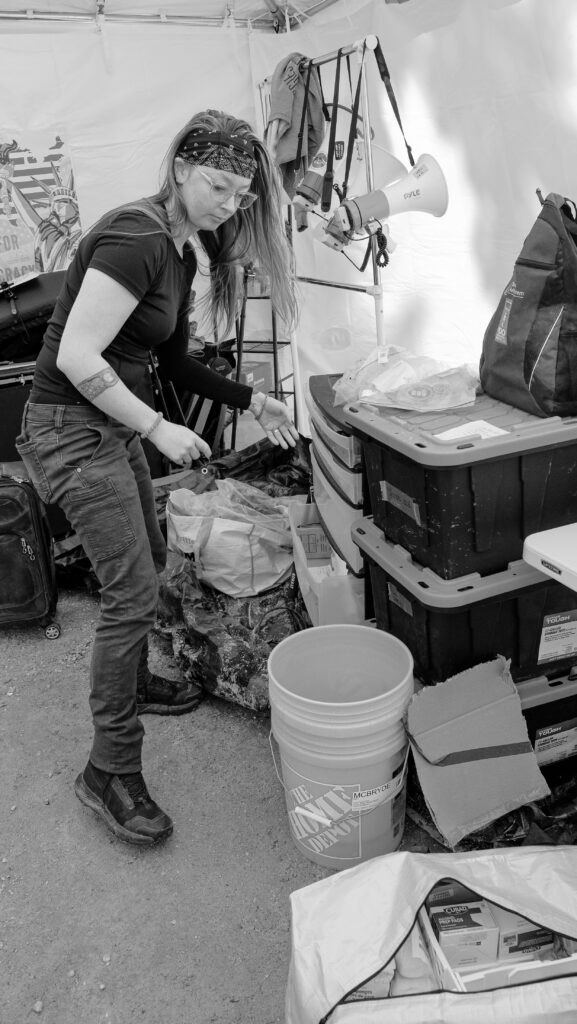
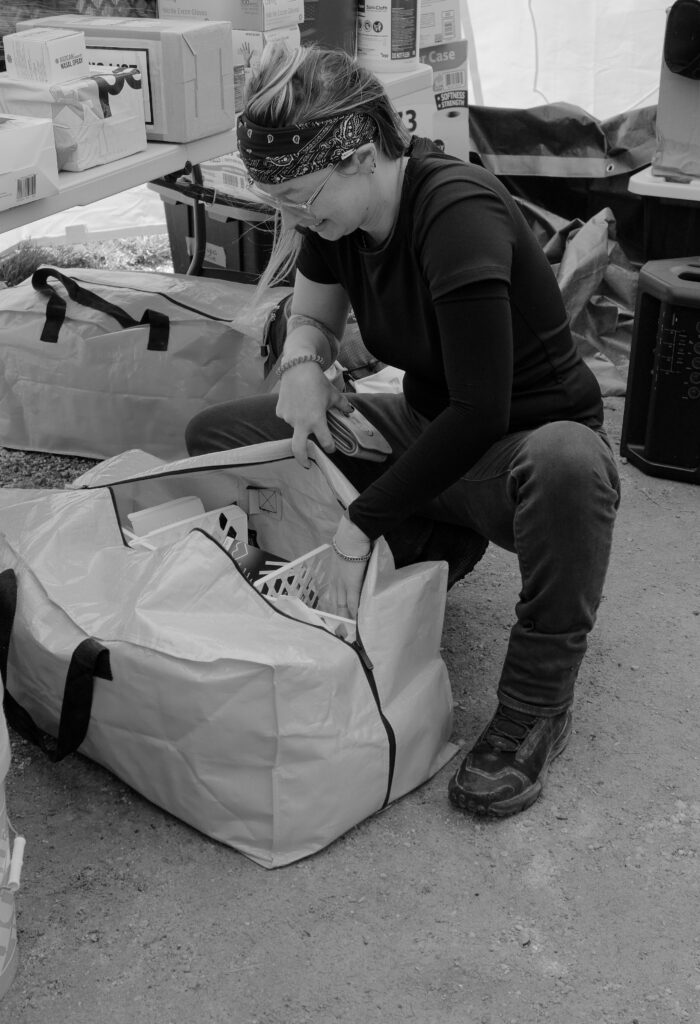
Most volunteers on site usually work up to nine hours at a time. But both Jey and CB have frequently worked night shifts at Mayday, with 12-hour shifts that run from roughly 7:00pm to 7:00am the next morning. When doing this, they often find themselves awake for 20 hours at a time as other needs arise, including their jobs, commuting from their homes, and supporting other operations for Mayday. Jey also works long shifts in her job as an ER trauma nurse, causing her to often be awake longer than most other volunteers on site.
Their experience during the COVID-19 pandemic, they say, has prepared them for the unpredictability and intensity of street medic work. “[I saw] how hard life can be, and how traumatic things can be firsthand, and learning to work through that and process that and handle that through knowing I’m doing something that makes a difference,” Jey told reporters. “So being able to do this for Mayday under similar horrible times—[it] kind of cures the same problem.”
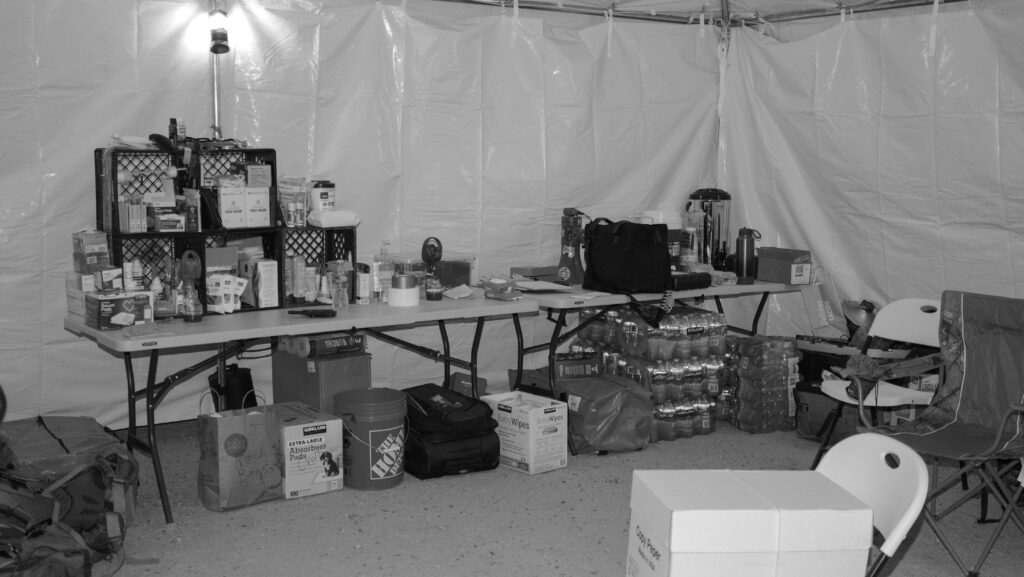
Similarly, CB shared experiences during COVID, saying: “[We] were understaffed, under supplied. PPE just wasn’t available. [We] didn’t have N95s and had to use paint respirators.” She has commented that these experiences helped prepare her for the logistics constraints that street medics often face.
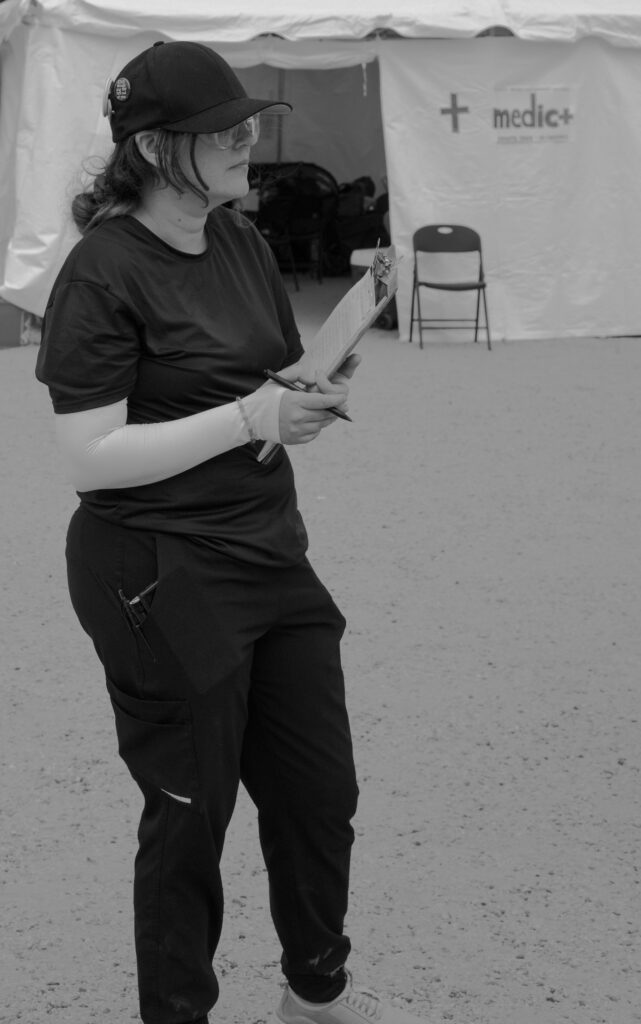
Both Jey and CB have also commented on the criticality of properly staffing the SMASH medic tent. “Having adequate staffing [at Mayday] is another struggle,” remarked CB during an interview, “but we want to make sure people are safe. We know it’s a numbers game and we’ll always be understaffed, so [we’re] focused now on getting people and getting them trained up.”
But these experiences and their prior work as street medics are the driving force behind SMASH, with CB commenting that “this isn’t charity; it’s solidarity.”
“Seeing the volunteer meds through 50501, there’s usually two or three [street medics] per protest [of potentially thousands]. But with this, there’s more support and people want to be here for the long run. Patient hand-off is only twice. We’re not just taking care of people who are on the pad. Anyone who needs care can come to this tent.”
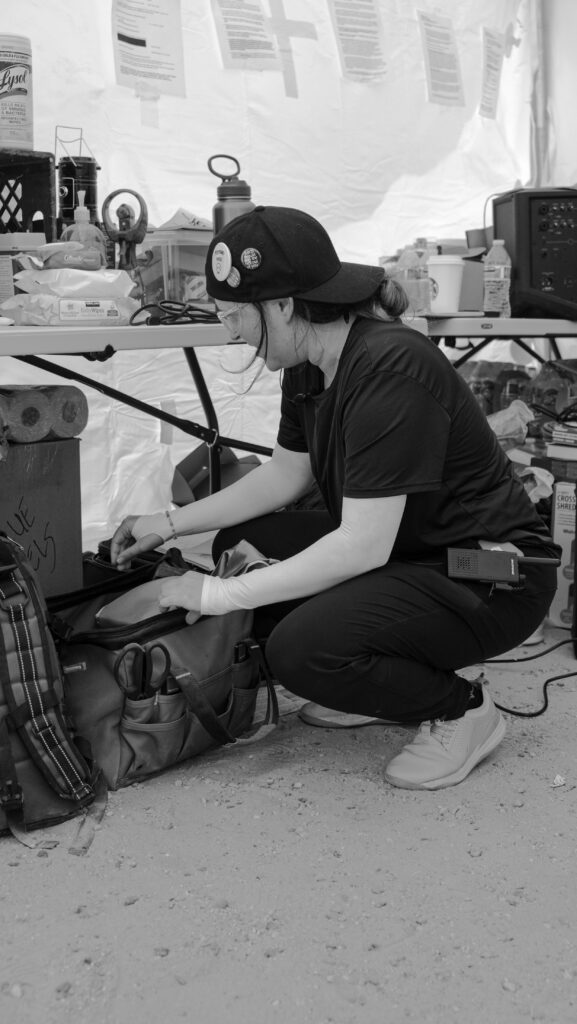
And now since starting SMASH, CB says they have raised around $1,000. Most of this comes from small donations, less than $50, with only a few larger than $100, and all of them unrestricted for the non-profit to use as it sees fit for its operations. “I would love it if someone gave $1,000 and said ‘only use this for Stop The Bleed,’” says CB, referring to the first responder training that teaches people how to control wounds that risk severe blood loss. According to CB, she and Jey have also contributed their own finances to SMASH, with CB bringing $300 worth of supplies the first week. Those expenses are not reimbursed to them, and they have stated that they do not collect income from SMASH.
SMASH is also working to provide free training to other Mayday volunteers, including CPR and Stop the Bleed. Stop the Bleed can cost as much as $50 per class, although some hospitals provide it for free, and CPR classes can cost as much as $76. But by providing these classes onsite for free, SMASH hopes to create a more capable volunteer force that can step in during emergencies.
CB also shared her vision for the future of SMASH beyond Mayday: building a network of private practice physicians who they can connect anyone injured onsite with for follow-up care nationally.
“If someone from Iowa gets hurt, I [want to] have a doctor in Iowa who could do follow-up with them. Ideally, I’d like to have a rolodex of four or five doctors in every state. That’s a large vision.”
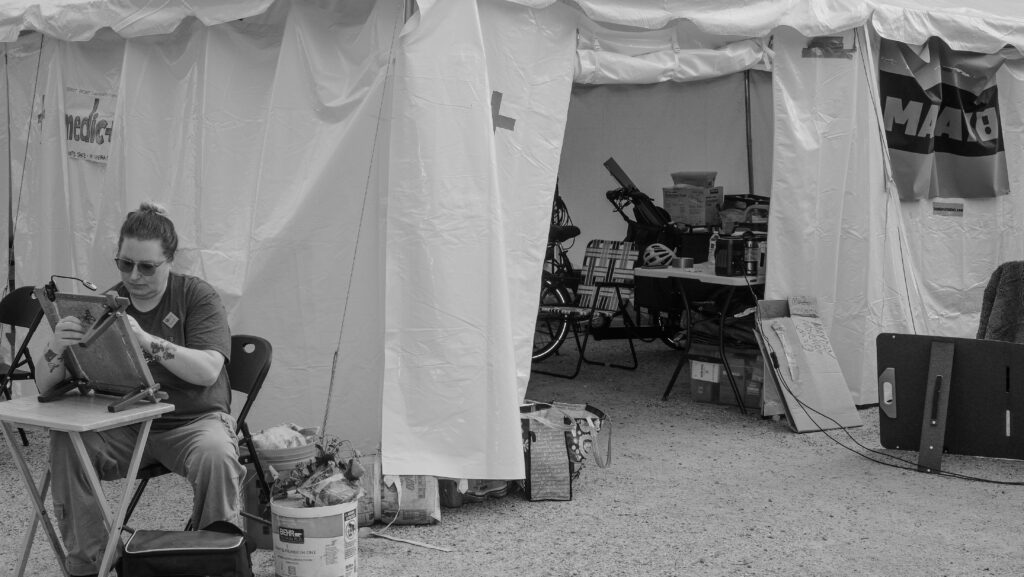
In partnering with Mayday, the SMASH team has also seen other medics slowly join, including a surgeon from North Carolina who travels with her daughter to give street medic support to activists, and a person who is First Aid certified from Maryland. Still, Jey and CB emphasize that more trained medics and donations are urgently needed. Despite new support trickling in, Jey often continues to work 20 hour days between her job and volunteer work. And while CB has taken a step back from commuting to Mayday every week, she continues to support other activism as a street medic around her home state.
Mayday Movement USA Sees Evolution in First Month
May 1-4
“I just offered the opportunity and people showed up.”
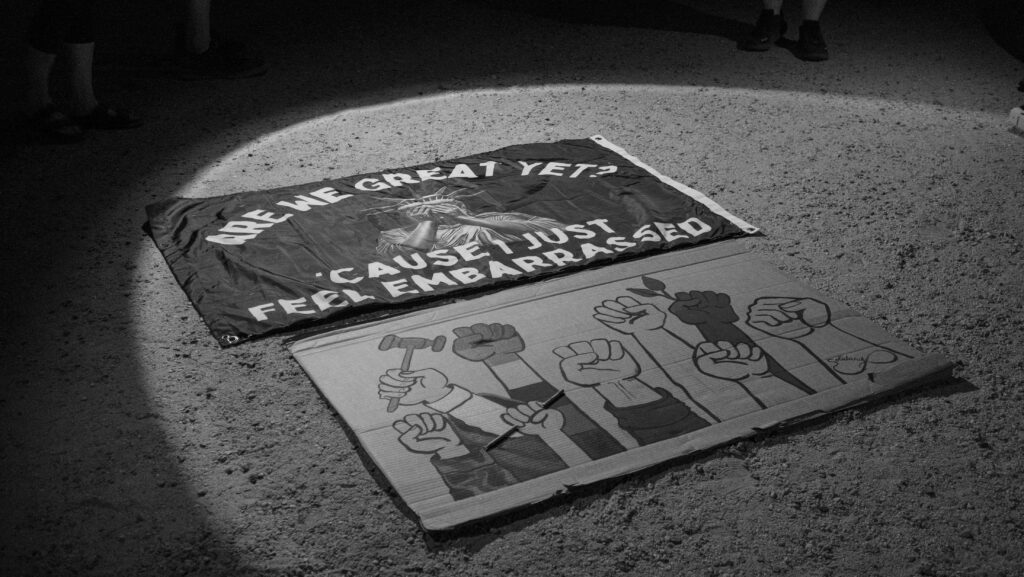
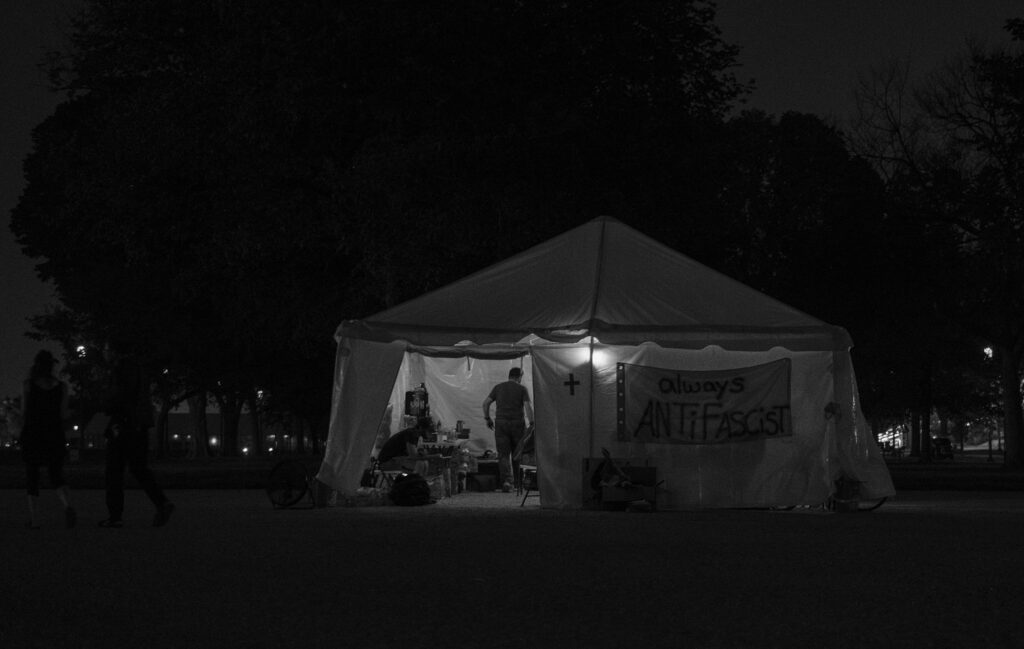
Within the first 72 hours, Mayday also had several notable guest speakers, including Dusty Gannon, better known by his TikTok handle, Goth Dad, who spoke to Mayday about the need for veterans to stand up against Trump.
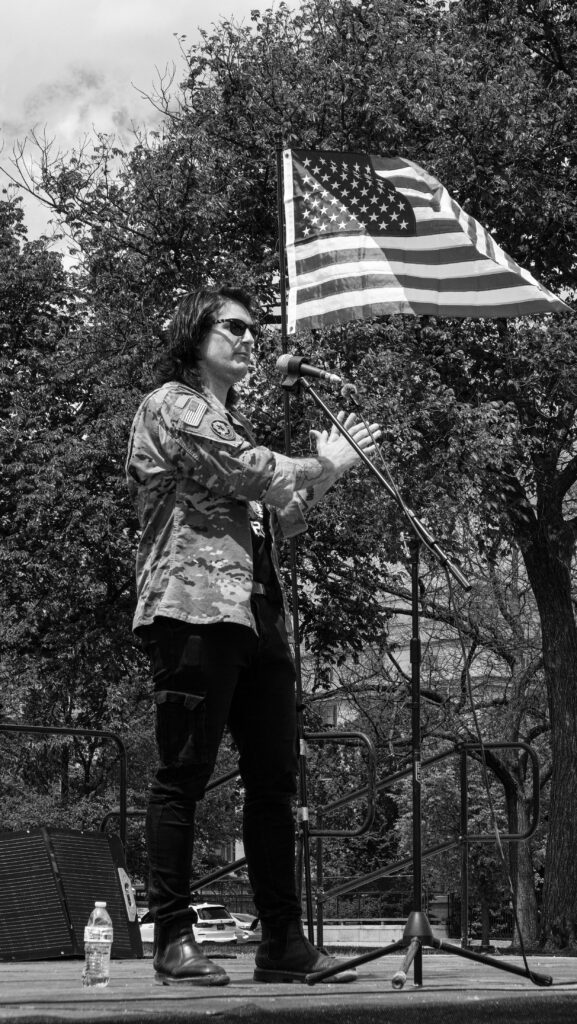
Also present was Dr. Rebecca Gaglia, who publicly announced for the first time her intent to run as an independent for the 2028 Presidential Elections.
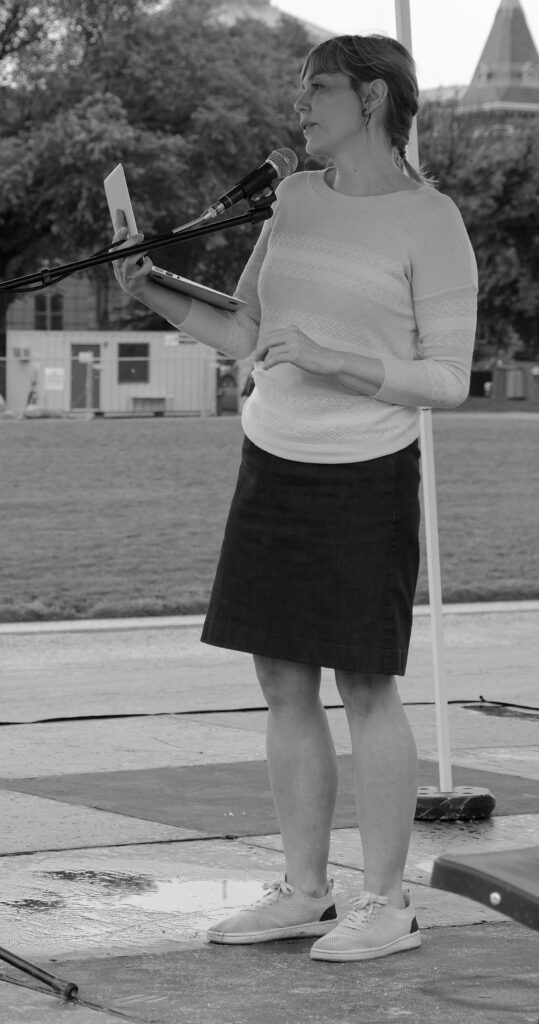
However, with permitting limitations that restrict things like preparing food onsite and sleeping on the Mall, volunteers quickly discovered limitations in the 24/7 goal and needed to adapt. This included working to find suitable lodging for volunteers offsite and having pre-packaged snacks available in the medical tent. The sleep restriction in particular places significant burden on Mayday, based on conversations with multiple volunteers, as volunteers take long shifts to man the plot that Mayday occupies, rain or shine. And since May 4, Mayday has begun to struggle to recruit large numbers of new volunteers to offset the burden on the original cadre, who still are on site. Recently, it has started to see some new recruits arrive to lessen this burden. Still, the original members remain steadfast that they have to see Mayday succeed.
In light of these challenges, Peter remarked that “we need more.”
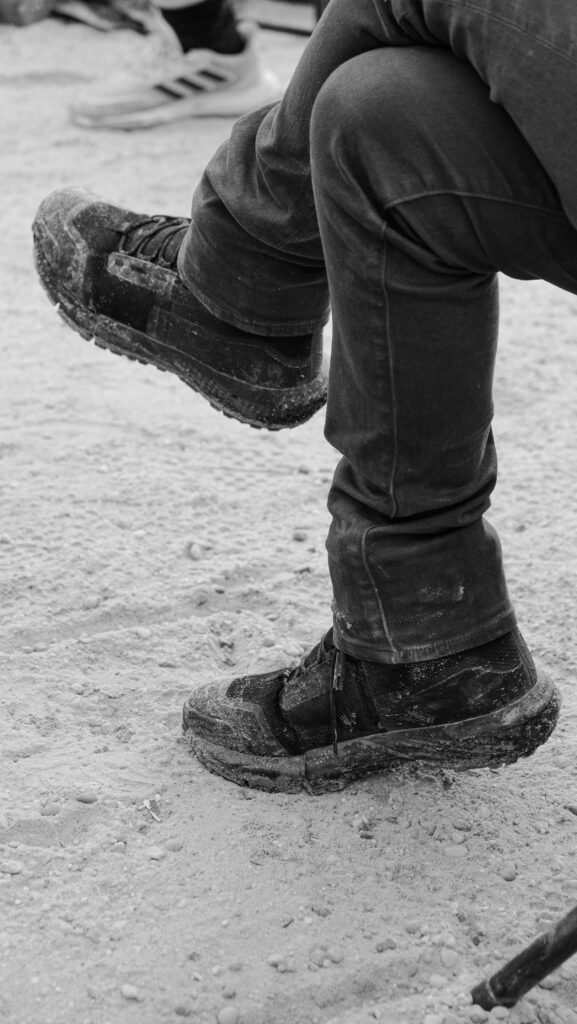
May 5-June 1
“People don’t seem to understand the depth of the crisis…”
Since May 4, volunteers have continued to man the Mayday’s post in those 9- to 12-hour shifts, with some pulling consecutive overnighters and others staying awake for 24 hours at a time. This was accompanied by multiple plot moves, as permitting required the Movement to shift their location every week. They are now able to hold a site in front of Union Station through July.

Along with this, volunteers have noted varying degrees of feeling underwhelmed by the general level of support they have seen for Mayday. Despite the increasing numbers of constituents that they have gained signatures from for impeachment, volunteers have described the space as feeling empty at times, as only four to 10 volunteers typically staff the site, and they do not see consistent presence of other participating protesters.
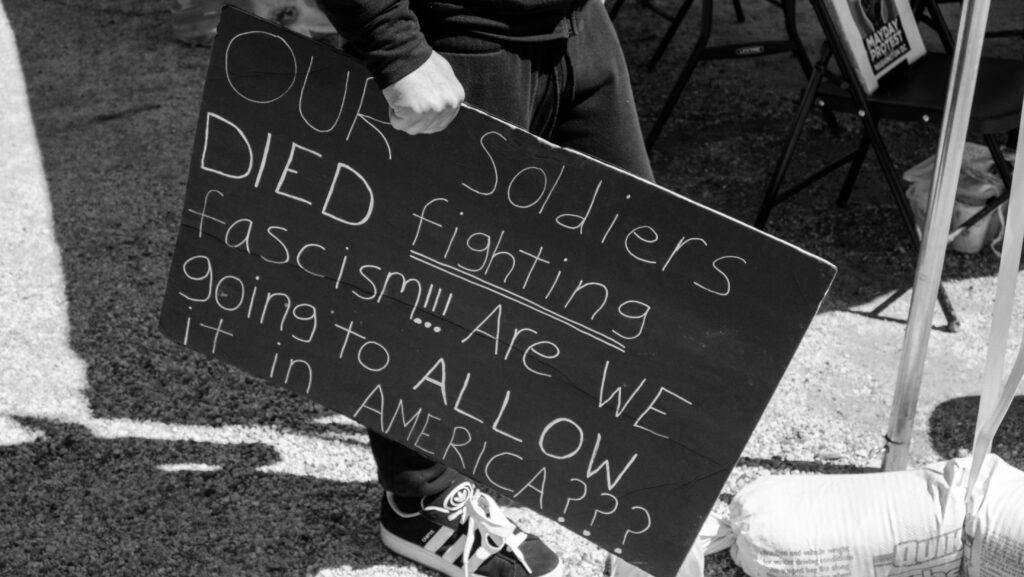
Peter has also shared this concern, noting that he hopes more people start to come. “People don’t seem to understand the depth of the crisis and don’t want to get out of their comfort zone because of that,” he said. Pressed on his ideal scenario, Peter commented that he would like to see busloads of people arrive daily, participate in art making, visit their representatives on the Hill, and return home, with a new group to arrive the following day. “I want to get to Ground Hog Day,” he said, alluding to this desired cycle of new, arriving protesters.
And the movement has seen some repeated guests, with Dr. Gaglia returning on June 1 to speak again during an art event cohosted by Mayday and 50501.
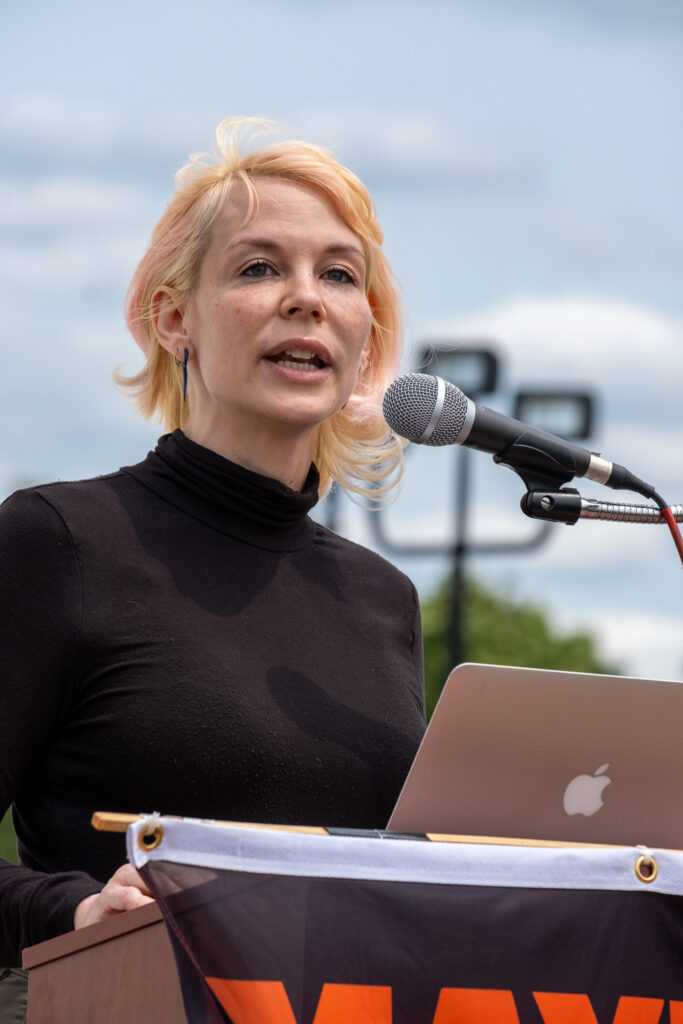
Mayday Navigating an Inflection Point
With the relative success Mayday has seen since starting, both in the presence it has on the Hill and the sheer motivation of its volunteers, it is approaching an inflection point. Peter has similarly remarked that Mayday is reaching a new phase, as volunteers shift from the virtual planning that took up the first two months from its inception, to now bringing that vision to physical reality.
Combined with this are natural tensions that emerge in grassroots movements, in particular ones with 24/7 operations that have to remain stable hour over hour. In recent weeks, Mayday has worked to address various concerns, including over donor transparency, as it works to establish its financial oversight and safety on the Mayday site. Compounding this is Mayday’s continued challenge to obtain bank accounts that it can move donations to from PayPal.
Note: Mayday’s donations are handled separately from SMASH’s donations, although SMASH does donate supplies to Mayday as part of its presence on Mayday’s site.
Volunteers have noted challenges with obtaining a bank account as some banks have allegedly expressed nervousness in partnering with the Movement. And already, some volunteers have indicated they may quit due to what they see as insufficient financial oversight and transparency.
Note: Copies of Mayday’s financial disclosures reviewed by reporters appear consistent with other standard 501(c)(3) financial disclosure documents in the categories and level of detail they capture. Mayday also has made efforts to increase transparency as a result of feedback from volunteers, including itemizing individual donations and purchases for any volunteer to audit.
A few volunteers have decided to step back over concerns of safety on the site, as the potential for persons unaffiliated with Mayday—or even other volunteers who, until arriving, are largely complete strangers—to potentially incite violence exists. While Mayday does have volunteers filling security roles, those who have stepped back have commented that they do not believe it to be sufficient.
Note: In a statement to press, a Mayday volunteer said there was an unhoused person allowed to be at the movement’s location, but who was consistently sleeping there despite warnings that this violates the permit. When one volunteer attempted to wake the individual up, the person allegedly threatened the volunteer. As a result, the person was told they could no longer be onsite. In another instance, an individual—who was unaffiliated with Mayday—picked up and threw a Mayday table, almost hitting another person. In both cases, volunteers who were present at the incidents stated that the individuals of concern were removed peacefully from Mayday’s site without further issue.
And on May 16, Mayday experienced a significant setback. A series of storms moved through DC, damaging multiple tents and causing significant property damage. According to volunteers who were there that night, some were actively holding the last main tent up—the medical tent—to keep it from collapsing in on itself. The storm required volunteers to surge support to replace equipment.
In June, new tents were finally delivered and volunteers have sought to find solutions to response challenges that the storm created. This includes ongoing discussions around what decisions should be made during disaster events, and who has the power to make those on behalf of the movement while retaining the grassroots, democratic vision it has in its operations.
Still, despite these challenges the majority of volunteers spoken to remain optimistic and emphatic that they are here to stay until “impeach, convict, remove” happens. Speaking with volunteers, one noted on May 23, “Something this stressful, there’s bound to be some tension. … But we’re doing alright.” Peter also remarked that “I believe that the only way things change is if we mass here in DC.”
In line with Peter’s comment, volunteers are now seeking to put more resources into the art wing and are beginning canvassing efforts to recruit new volunteers. The damaged tents have also been replaced, and Mayday continues to find ways to navigate permitting limitations to place more art around the site.
And multiple volunteers continue to comment that they are here to stay, even if it takes all four years of Trump’s presidency, despite the challenges they have experienced. According to one volunteer from Missouri: “We’ve received that question a lot, ‘will you stay for four years?’ [I]f that’s what it takes. No matter how long it takes, you have to keep trying. You can’t just do nothing.”
Riley Harty is an independent photojournalist covering social activism in and around Washington, DC. Since May 1, he has been embedded with Mayday Movement USA to provide coverage of their activities and document the evolution of their efforts.